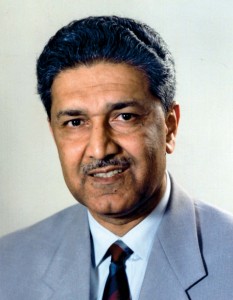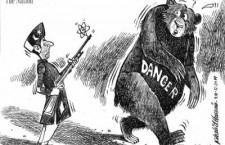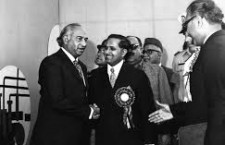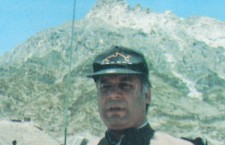Foundations of Pakistan’s Nuclear Program
A look at why and how Pakistan went nuclear
Engr. Sarfraz Nawaz
When mountains moved and turned pale with the intensity of the shake, Pakistan crossed the nuclear threshold to become a declared nuclear weapons state on May 28, 1998 by detonating five nuclear devices in the Ras Koh Hills in Chagai area of Balochistan province, in response to India’s five tests two weeks earlier. Pakistan therefore proudly celebrates this day as “Youm-e-Takbir,” which translates as the “Day of Greatness,” to commemorate the country’s achievement. It was the day Pakistan became a member of the elite nuclear powers club – the seventh nation in the world and the first in the Muslim comity to publicly test nuclear weapons. In the instant write-up, a discourse on the basis of Pakistan’s nuclear program is being presented.
Pakistan’s nuclear program is a result of gradually changing circumstances, global, regional, and national. For example, its nuclear policy may be traced back to the mid-1950s and a focused historical narrative shows to assess how that policy evolved. It shows how Pakistan gradually moved from a civilian to a civil-military nuclear program and ultimately a de facto nuclear weapon state. The first began in 1954 when Pakistan conceived of a nuclear program and ended in 1971.
Its program was inspired by “Atoms for Peace” program proposal which American President Dwight Eisenhower announced in his deliberation to the General Assembly on December 8, 1953. The second phase began in December 1971 with Zulfikar Ali Bhutto’s accession to the presidency. This was the most decisive period as Pakistan shifted its civil nuclear energy program to military-oriented missions.
The nuclear weapon program of a sovereign nation is not static but dynamic and determined by the larger forces and interests at work both within the region and outside. Further regional security cannot be considered in isolation from global or extra-regional conditions. In contrast to India, Pakistan’s nuclear program is driven mainly by its threat perception and security concerns with respect to India. It sees its potential nuclear forces as a deterrent to India’s conventional military advantages and strategic ambitions. The South Asian nuclear security complex involves several security dilemmas, including Pakistan/India, India/China, and Russia /USA. Pakistan’s developing concept from ‘Atoms for Peace’ to detonation in May 1998 is not driven by any single theory but a cluster of factors that include-military, security, political prestige and influence, economic gains and domestic pressures and compulsions.
 Pakistan had emerged as an independent country in August 1947 but did not embark on a nuclear program immediately. The first step in this direction was taken in 1953 with the setting up of an Atomic Energy Council (AEC) under the chairmanship of Dr Nazir Ahmed whose task included: (i) survey of radioactive minerals, (ii) working out a plan for the establishment of an atomic energy institute, and (iii) making recommendations on all matters connected with using atomic energy. Being inspired by the US President’s call for “Atoms for Peace” in December 1953, Pakistan’s nuclear program was conceived in October 1954 and its Industry Minister announced a plan to set up a national atomic research unit as part of a new body for scientific and industrial research. A twelve-member Atomic Energy Committee headed by Dr. Nazir was formed on whose recommendation, an Atomic Energy Council was set up in March 1956 consisting of a governing body and an Atomic Energy Commission (PAEC). It was made responsible for implementing the government’s goals for the Council. The first attempt to construct a nuclear research reactor and to establish a number of nuclear research centres and facilities for atomic Research and Development in medicine and agriculture was made in 1958, it however, could not produce substantive results as sufficient funds were not allocated for this plan.
Pakistan had emerged as an independent country in August 1947 but did not embark on a nuclear program immediately. The first step in this direction was taken in 1953 with the setting up of an Atomic Energy Council (AEC) under the chairmanship of Dr Nazir Ahmed whose task included: (i) survey of radioactive minerals, (ii) working out a plan for the establishment of an atomic energy institute, and (iii) making recommendations on all matters connected with using atomic energy. Being inspired by the US President’s call for “Atoms for Peace” in December 1953, Pakistan’s nuclear program was conceived in October 1954 and its Industry Minister announced a plan to set up a national atomic research unit as part of a new body for scientific and industrial research. A twelve-member Atomic Energy Committee headed by Dr. Nazir was formed on whose recommendation, an Atomic Energy Council was set up in March 1956 consisting of a governing body and an Atomic Energy Commission (PAEC). It was made responsible for implementing the government’s goals for the Council. The first attempt to construct a nuclear research reactor and to establish a number of nuclear research centres and facilities for atomic Research and Development in medicine and agriculture was made in 1958, it however, could not produce substantive results as sufficient funds were not allocated for this plan.
The year 1960 proved significant three reasons. First, the nuclear program acquired a new patron, Mineral and Natural Resources the Minister Zulfikar Ali Bhutto. Second, Dr Ishrat H. Usmani was appointed PAEC Chairman and also made responsible for setting in motion many of the critical programs and institutions that later gave Pakistan nuclear weapons. Usmani started the Pakistan Institute of Nuclear Science and Technology, the Pakistan Institute of Science and Technology and the Karachi Nuclear Power Plant. His achievements include the training program under which brilliant young Pakistanis were selected and sent for training abroad. Between 1960 and 1967. Some 600 were selected, of whom 106 eventually returned with doctorates. And third, also in 1960, the USA gave Pakistan a $350,000 grant to help prepare Pakistan for its first research reactor which the USA agreed to supply two years later.
Three years later in 1963 Bhutto became the Foreign Minister and carried his interest in nuclear capabilities into office with him. In fact he was the chief architect of Pakistan’s nuclear policy and program. Under him, Islamabad’s nuclear thinking underwent a significant change. Earlier, when the PAEC was established he was confident it would vigorously pursue its objective of paving the way for Pakistan to join the nuclear club. In his calculations: (i) A bomb would be a status symbol not only for Pakistan but the entire Islamic world; (ii) it would fetch aid and oil supply from the sympathetic Muslim states; and (iii) would give Pakistan enough leverage to put India into the defensive.
Bhutto’s vision of nuclear weapons represented a trump card in his foreign policy. In his view, Pakistan would become the first Muslim country with the bomb. Among the rich and security-anxious Arab States with whom he planned to share the secrets, success would enhance Pakistan’s stature and importance incalculably. There is also evidence that heavy funds were injected by the Libyans to promote his plan which, if realized, would tip the balance of power in the Middle East. On the other hand, after 1960, the Ayub Government also put some emphasis on the development of nuclear energy in Pakistan. In the second national five-year plan (1960-1965), Rs. 46.5 million was allocated to the nuclear sector to be used for the training of nuclear scientists, exploration of radioactive minerals, establishment of different types of nuclear research reactors and a number of medical and agricultural centres using isotopes technique. Between 1960 and 1968, the Pakistani Government in fact spent Rs. 324 million for the development of nuclear technology in addition to Rs. 400 million for the construction of Karachi Nuclear Power Project (KANUPP).
Around the mid-1960s Pakistan’s nuclear weapon program went a step further and a clear policy shift appeared in government circles. Citing Indian advances in nuclear fuel processing and the 1965 India-Pakistan war, the Pakistan Foreign Office and Foreign Minister Zulfikar Ali Bhutto began lobbying for a nuclear weapons option. Further at the close of 1960s (1969) the United Kingdom Atomic Energy Agency agreed to supply a downscaled version of a nuclear fuel reprocessing plant, in operation at Windscale in Britain, to Pakistan. On 6 March 1970 the Nuclear Nonproliferation Treaty (NPT) came into force with the ratification of the USA, USSR and the Great Britain but Islamabad refused to sign the instruments of ratification. It showed basic shifts in Pakistan’s nuclear policy.
How Pakistan secures its nukes
Pakistan believes that nuclear security demands constant vigilance, perpetual preparedness and zero complacency. Pakistan, therefore, accords utmost importance to nuclear security as a prime national responsibility. Over the years, Pakistan has established a comprehensive and effective national nuclear security regime, which covers nuclear material and other radioactive materials, and associated facilities and activities throughout their lifecycle. In order to remain abreast with the emerging threats and challenges, national nuclear security regime is regularly reviewed and updated in the light of national obligations, the International Atomic Energy Agency (IAEA) guidance documents and international best practices. A robust nuclear security culture has evolved over a period of time that helps in strengthening and sustaining the national nuclear security regime.
3 Pillars of Pakistan’s Nuclear Security Regime
Legislative and regulatory framework and administrative systems and measures governing the security of nuclear material, other radioactive material, associated facilities and activities.
Institutions and organizations within the State responsible for ensuring the implementation of the legislative and regulatory framework and administrative systems of nuclear security.
Nuclear security systems and measures meant for the prevention and response to nuclear security events.
 Jahangir's World Times First Comprehensive Magazine for students/teachers of competitive exams and general readers as well.
Jahangir's World Times First Comprehensive Magazine for students/teachers of competitive exams and general readers as well.



